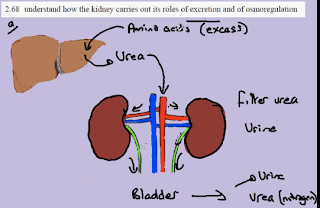describe the structure of the nephron to include the Bowman's capsule and the glomerulus converted tubules, Loop of Henle and the collecting duct.
-nephron- functional unit of the kidney. part that does the filtration and the controlling of the composition of the blood.
-branch of aorta- taking blood into the kidney is the renal artery.
-kidney filters the blood and the contents which are removed from the blood (excreted) are called urine which comes down the structure called the ureter and collects in the bladder for release.
-the filtered blood exits in the renal vein and returns to the vena cava.
-if we slice the kidney in half to show the internal structure we see different colour regions.
-lighter colour is called the cortex.
-darker colour is called the medulla.
-the space in the middle (lighter colour) is called the pelvic region. space is where the urine collects and drains down the ureter.
-the reason for the different colours is because the kidneys is made up of many million tubilar structures tubes.
-the tubes starts on the edge of the medulla and moves directly upwards through the medulla and out into the cortex and dips into the medulla again and back up and comes to a dead end.
-the dead end is called the bowman's capsule.
-the structure is called the nephron.
-above the dotted line is the cortex and below the dotted line is the medulla and the dotted line where the tube ends is the pelvic (where urine emerges).
-the tube is made up of twisted sections called the convoluted tubules.
-duct= tube.
-the dip is called the loop of Henle. (dips into the medulla)
-the dead end cup shape structure is called the bowman's capsule.
-the tight knot of blood vessels in the bowman's capsule is called the glomerulus.
-the first twisted section is called the proximal convoluted tubules (PCT)
-the second twisted section is called the distal convoluted tubules (DCT)
-the arrangement of this nephron structure which gives the different colour regions in the kidney.
-there are millions of nephrons in a single kidney.
















































